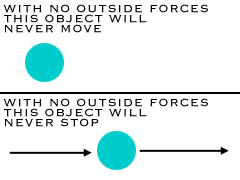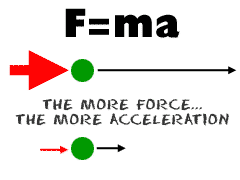Newton created three laws of motion. Newton's laws of motion are three physical laws that together laid the foundation for classical mechanics. They describe the relationship between a body and the forces acting upon it, and its motion in response to said forces. The three laws, though expressed differently, can be summarised as follows:
- Every object in a state of uniform motion tends to remain in that state of motion unless an external force is applied to it.
- The relationship between an object's mass m, its acceleration a, and the applied force F is F = ma. Acceleration and force are vectors in this law the direction of the force vector is the same as the direction of the acceleration vector.
- For every action there is an equal and opposite reaction.
The first law is famously known as the law of inertia, which explains how something cannot start or stop moving, increase or decrease its speed, or change directions without another force.
 |
| The first law of motion |
An object continues to do whatever it happens to be doing unless a force is exerted upon it. If it is at rest, it continues in a state of rest. This is demonstrated when a tablecloth is whipped from under dishes on a tabletop and the dishes remain in their initial state of rest. If an object is moving, it continues to move without turning or changing its speed. This is evident in space probes that continually move in outer space. Changes in motion must be imposed against the tendency of an object to retain its state of motion. In the absence of net forces, a moving object tends to move along a straight line path indefinitely.
 |
| The Second Law of Motion |
The second law says that the acceleration of an object produced by a net applied force is directly related to the magnitude of the force, the same direction as the force, and inversely related to the mass of the object. This shows that although one exerts the same amount of force on two different objects, the acceleration might be different. The acceleration on the smaller mass will be greater, for example, the effect of a 10 newton force on a baseball would be much greater than that same force acting on a truck. The difference in effect (acceleration) is entirely due to the difference in their masses.
The third laws says that forces are found in pairs. Think about the time you sit in a chair. Your body exerts a force downward and that chair needs to exert an equal force upward or the chair will collapse. The gravity is the force pulling it down, while there is an upward force that keeps you on the chair. Acting forces encounter other forces in the opposite direction.


No comments:
Post a Comment